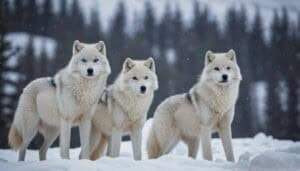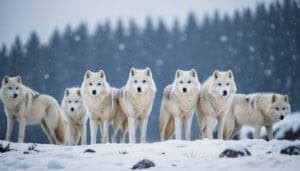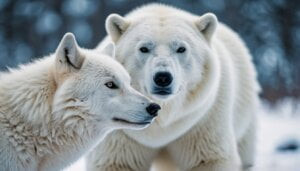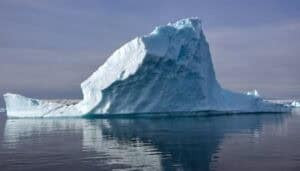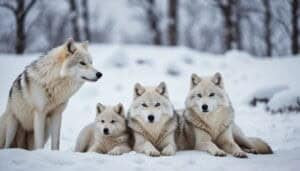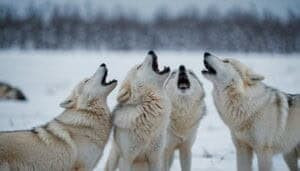Introduction
Arctic wolves, resilient inhabitants of one of the harshest environments on Earth, exhibit unique genetic diversity that plays a crucial role in their survival and adaptability
This article delves into the factors contributing to their genetic diversity, the methods used to measure it, and the impact it has on their health and longevity
Additionally, we explore the influence of the Arctic environment and inbreeding on their genetics, the conservation efforts in place, and the implications of climate change. Finally, we examine the consequences of low genetic diversity and the strategies employed to enhance it
Contributing Factors and Measurements of Genetic Diversity
The genetic diversity within Arctic wolf populations is influenced by various factors and measured using several advanced techniques. Understanding these contributing elements and methods provides insight into the genetic health and adaptability of these remarkable animals
Historical Population Sizes and Movements
Historical population sizes and movements have played a significant role in shaping the genetic diversity of Arctic wolves
During the last Ice Age, the distribution of Arctic wolves was likely broader, encompassing various regions of the Northern Hemisphere. As glaciers receded, these wolves adapted to the changing environments, leading to isolated populations that developed unique genetic traits
For example, studies have shown that historical bottlenecks, where populations were reduced to small numbers, can decrease genetic diversity. Such events can lead to a reduction in the gene pool, limiting the genetic variability available for future generations. Conversely, periods of population expansion can increase genetic diversity by introducing new genetic variations
Breeding Patterns and Gene Flow
Breeding patterns and gene flow are crucial in maintaining and enhancing genetic diversity
In Arctic wolves, breeding typically occurs once a year, and pack dynamics play a significant role in gene flow. Packs are usually composed of a dominant breeding pair and their offspring, with the dominant pair contributing most of the genetic material to the next generation
Gene flow occurs when individuals from different packs mate, introducing new genetic material into the population. This process helps prevent inbreeding and promotes genetic diversity. However, the harsh Arctic environment can limit gene flow by creating physical barriers that isolate wolf packs
Geographic Isolation and Its Effects
Geographic isolation is a significant factor affecting genetic diversity in Arctic wolf populations. The vast and fragmented landscape of the Arctic can isolate wolf packs, leading to limited genetic exchange between populations
This isolation can result in genetic drift, where certain genetic traits become more common within isolated populations due to random chance rather than natural selection
The effects of geographic isolation can be seen in the distinct genetic variations observed among Arctic wolf subpopulations. For instance, wolves in different regions of the Arctic may exhibit variations in coat color, size, and other physical traits, reflecting their adaptation to specific environmental conditions
Genetic Markers and Techniques Used
Researchers use various genetic markers and techniques to measure genetic diversity in Arctic wolves
One common method is analyzing microsatellites, which are short, repetitive DNA sequences that vary significantly between individuals. Microsatellite analysis can provide detailed information about genetic diversity, population structure, and gene flow
Another technique is mitochondrial DNA (mtDNA) analysis, which focuses on the genetic material inherited from the mother. MtDNA is useful for studying the genetic history and evolutionary relationships of populations. By comparing mtDNA sequences from different individuals, researchers can infer patterns of maternal lineage and migration
Field Studies and Data Collection Methods
Field studies and data collection are essential components of genetic research on Arctic wolves. Researchers collect genetic samples through non-invasive methods, such as collecting feces, hair, or saliva, which contain DNA. These samples are then analyzed in the lab to extract and study genetic material
In addition to genetic samples, researchers also gather data on wolf behavior, pack dynamics, and environmental conditions. This comprehensive approach helps contextualize genetic findings and provides a deeper understanding of the factors influencing genetic diversity
Analysis and Interpretation of Genetic Data
Once genetic data is collected, researchers analyze and interpret the information to draw conclusions about the genetic diversity of Arctic wolf populations
Statistical methods, such as population genetic models and phylogenetic analysis, are used to assess genetic variation and relationships among individuals and populations
Interpreting genetic data involves understanding the significance of genetic markers, gene flow, and the impact of historical events on genetic diversity. By integrating genetic data with ecological and behavioral information, researchers can develop strategies to conserve and manage Arctic wolf populations effectively
Impact and Variations in Genetic Diversity
Understanding the genetic diversity within Arctic wolf populations is critical for assessing their overall health and adaptability
Genetic diversity impacts various aspects of their biology, from disease resistance to adaptability, and observing the variations within populations can provide insights into their evolutionary success and challenges
Disease Resistance and Health
Genetic diversity plays a vital role in the disease resistance and overall health of Arctic wolves. A diverse gene pool can provide a range of immune responses to pathogens, enhancing the population’s ability to withstand diseases
Studies have shown that populations with higher genetic diversity are less susceptible to outbreaks of diseases such as canine distemper and mange, which can have devastating effects on wolf populations
For instance, a study on the genetic diversity of wolves in Scandinavia found that populations with greater genetic variation had higher survival rates and lower incidences of disease (Åkesson et al., 2016). This highlights the importance of maintaining genetic diversity to ensure the long-term health and viability of Arctic wolf populations
Adaptability to Environmental Changes
Genetic diversity is crucial for the adaptability of Arctic wolves to environmental changes
The Arctic environment is characterized by extreme conditions, with harsh winters, limited food availability, and seasonal variations. Genetic diversity enables populations to adapt to these changing conditions by providing a wide range of traits that can be advantageous in different environments
For example, variations in fur color and density can help wolves camouflage in different seasons and regulate their body temperature. Genetic diversity also supports behavioral adaptability, such as hunting strategies and social structures, which are essential for survival in the Arctic
Reproductive Success and Longevity
The reproductive success and longevity of Arctic wolves are directly influenced by their genetic diversity. A diverse gene pool can enhance reproductive fitness by reducing the risks associated with inbreeding, such as congenital defects and reduced fertility
Inbreeding depression, a consequence of low genetic diversity, can lead to smaller litter sizes, higher infant mortality, and shorter lifespans
Research on the Isle Royale wolf population, which suffered from inbreeding due to isolation, showed a significant decline in reproductive success and an increase in genetic disorders (Adams et al., 2011). This case underscores the importance of genetic diversity in ensuring the reproductive success and longevity of wolf populations
Common Genetic Traits and Variations
Arctic wolves exhibit various common genetic traits and variations that reflect their adaptation to the environment
Some of these traits include thick, insulating fur, which protects them from extreme cold, and a robust body structure suited for traversing snowy landscapes. Genetic variations in these traits can occur within and between populations, influenced by factors such as geographic location and environmental pressures
Differences Between Subpopulations
Differences in genetic diversity between Arctic wolf subpopulations can provide insights into their evolutionary history and adaptability
Subpopulations isolated by geographic barriers or environmental conditions often develop distinct genetic traits. These differences can be observed in physical characteristics, behaviors, and genetic markers
For instance, Arctic wolves in different regions of the Arctic, such as Greenland, Canada, and Alaska, may exhibit unique genetic signatures that reflect their adaptation to local conditions. Studying these subpopulations can help researchers understand how isolation and environmental factors drive genetic divergence
Case Studies and Research Findings
Several case studies and research findings have highlighted the importance of genetic diversity in Arctic wolves
For example, a study conducted on the genetic diversity of Arctic wolves in Canada found significant variations between wolves in different regions, emphasizing the role of geographic isolation in shaping genetic diversity (Musiani et al., 2007)
Another study on the wolves of Greenland revealed unique genetic adaptations to the local environment, including traits related to fur density and hunting behaviors (Carmichael et al., 2008). These findings underscore the importance of preserving genetic diversity to ensure the adaptability and survival of Arctic wolf populations in a changing world
Environmental and Inbreeding Influences
Arctic wolves face unique challenges due to their harsh environment and the risks associated with inbreeding. Understanding how environmental factors and inbreeding influence genetic diversity can provide insights into the overall health and sustainability of these populations
Environmental Stressors and Adaptations
Arctic wolves are subjected to various environmental stressors that can influence their genetic diversity and adaptations. Extreme cold, scarce food resources, and seasonal changes all play a role in shaping the genetic traits of these wolves
For example, the development of thick fur and fat reserves are adaptations to the cold. These traits are heritable and can vary within the population, providing a genetic advantage in surviving harsh winters. Similarly, hunting strategies may evolve to cope with the availability of prey, leading to behavioral adaptations that are also influenced by genetics
Environmental stressors can also lead to genetic changes over time. For instance, a prolonged scarcity of prey may select for wolves with better hunting efficiency or those that can travel longer distances to find food. These genetic adaptations enhance the wolves’ ability to survive in their challenging habitat
Seasonal and Long-term Environmental Changes
Seasonal and long-term environmental changes have significant impacts on Arctic wolf populations
The Arctic region is characterized by extreme seasonal variations, with long, harsh winters and short, mild summers. These seasonal changes influence the availability of prey and the conditions for survival
During the winter, when prey is scarce, wolves may rely on stored fat reserves and their ability to hunt in packs. Genetic traits that enhance cooperation and pack hunting strategies can be advantageous during these times. Conversely, in the summer, the abundance of prey can lead to different genetic traits being favored, such as those that improve individual hunting skills
Long-term environmental changes, such as climate change, can also affect genetic diversity. As the Arctic warms, the habitat and prey availability for wolves may shift, leading to changes in their genetic traits. For example, wolves may need to adapt to new prey species or different hunting conditions, driving evolutionary changes in their genetic makeup
Interaction with Other Species
The interaction between Arctic wolves and other species can also influence their genetic diversity. Predation, competition, and symbiotic relationships all play a role in shaping the genetic traits of wolf populations
For instance, the presence of other predators, such as polar bears, can influence wolf behavior and genetic traits. Wolves that are better at avoiding conflict or competing for prey may have a genetic advantage
Additionally, symbiotic relationships, such as those with scavenger species that follow wolf packs, can also affect genetic diversity by influencing hunting success and food availability
Risks and Consequences of Inbreeding
Inbreeding poses significant risks to Arctic wolf populations, particularly in isolated or small populations where genetic diversity is already limited. Inbreeding occurs when closely related individuals mate, leading to a higher likelihood of offspring inheriting harmful genetic mutations
Inbreeding depression, the reduced biological fitness resulting from inbreeding, can manifest in various ways. These include increased susceptibility to diseases, reduced fertility, higher infant mortality, and congenital defects. For example, in the isolated Isle Royale wolf population, inbreeding has led to physical deformities and a significant decline in population health (Adams et al., 2011)
Inbreeding Avoidance Strategies
Arctic wolves have developed several strategies to avoid inbreeding and maintain genetic diversity
Dispersal, where individuals leave their natal pack to join or form new packs, is one common strategy. This behavior reduces the likelihood of mating with close relatives and promotes gene flow between populations
Another strategy is the formation of social structures within packs. Dominant breeding pairs usually exclude other pack members from breeding, reducing the risk of inbreeding within the pack. These social dynamics help ensure that genetic diversity is maintained within the population
Genetic Health Monitoring
Monitoring the genetic health of Arctic wolf populations is essential for their conservation and management. Genetic health monitoring involves regular assessment of genetic diversity, identifying inbreeding levels, and detecting genetic disorders
Researchers use various tools and techniques for genetic health monitoring, including DNA analysis and genetic markers
These methods help identify individuals at risk of inbreeding and guide conservation efforts to maintain genetic diversity. For example, translocation, where individuals are moved between populations, can be used to introduce new genetic material and reduce inbreeding risks
Conservation and Climate Change Implications
Maintaining the genetic diversity of Arctic wolf populations is crucial for their long-term survival, particularly in the face of climate change. Conservation efforts aim to protect and enhance genetic diversity, while understanding the implications of climate change on these populations helps guide these efforts
Protection of Habitats and Corridors
Conserving the natural habitats of Arctic wolves is essential for maintaining their genetic diversity. Habitat protection ensures that wolf populations have access to sufficient food resources, breeding grounds, and territories, which are critical for their survival and reproduction
One effective strategy is the establishment of protected areas, such as national parks and wildlife reserves, where human activities are limited. These protected areas can serve as safe havens for wolf populations, allowing them to thrive without the pressures of habitat destruction and human encroachment
Additionally, creating wildlife corridors that connect isolated habitats can promote gene flow between wolf populations. These corridors enable wolves to move freely between different regions, reducing the risk of inbreeding and increasing genetic diversity
For example, the Yukon to Yellowstone Initiative aims to create a continuous corridor for wildlife, including wolves, across North America
Breeding Programs and Genetic Management
Breeding programs and genetic management are vital tools for conserving Arctic wolf populations. These programs involve the careful selection and breeding of individuals to enhance genetic diversity and reduce the risks of inbreeding
Captive breeding programs can serve as genetic reservoirs, preserving the genetic material of wolf populations that may be declining in the wild. These programs can also support reintroduction efforts, where captive-bred wolves are released into their natural habitats to bolster wild populations
Genetic management involves monitoring the genetic health of both captive and wild populations. By assessing genetic diversity and inbreeding levels, conservationists can make informed decisions about breeding strategies and translocation efforts. This approach helps maintain a healthy gene pool and ensures the long-term viability of wolf populations
International Collaboration and Policy
Conserving Arctic wolves requires international collaboration and comprehensive policies, given their wide-ranging habitats that span multiple countries. Cooperation between nations can facilitate the sharing of knowledge, resources, and best practices for wolf conservation
International agreements, such as the Convention on Biological Diversity (CBD), encourage countries to take collective action to protect biodiversity, including Arctic wolves. These agreements can support the creation of transboundary protected areas and wildlife corridors, promoting genetic diversity across national borders
Policies that regulate hunting, land use, and climate change mitigation are also critical for wolf conservation. Implementing and enforcing these policies can reduce human-induced threats to wolf populations and their habitats
Shifts in Habitat and Food Sources
Climate change is causing significant shifts in the habitat and food sources of Arctic wolves. As temperatures rise, the Arctic tundra is transforming, affecting the availability of prey and the suitability of habitats for wolves
For instance, the warming climate is leading to a northward shift in the distribution of prey species, such as caribou and muskoxen. Wolves may need to adapt to these changes by altering their hunting strategies and expanding their range
Genetic diversity plays a key role in this adaptability, as it provides the genetic traits necessary for wolves to cope with new environmental conditions
Additionally, changes in vegetation due to climate change can impact the entire Arctic ecosystem, influencing the prey-predator dynamics. Monitoring these shifts and understanding their effects on wolf populations are essential for developing adaptive conservation strategies
Impact on Breeding and Migration Patterns
Climate change is also affecting the breeding and migration patterns of Arctic wolves. Warmer temperatures and changing snow conditions can alter the timing of breeding seasons and the availability of denning sites, which are critical for raising pups
For example, earlier snowmelt and longer summers may disrupt the traditional breeding cycles of wolves, leading to mismatches in the timing of prey availability and pup rearing. Genetic diversity helps wolves adapt to these changes, but continuous monitoring is necessary to assess the long-term impacts
Migration patterns are also influenced by climate change. As habitats and prey distributions shift, wolves may need to travel longer distances or explore new territories to find food and suitable living conditions. Genetic diversity supports this adaptability, but conservation efforts must ensure that wolves can safely migrate and access new habitats
Future Projections and Conservation Strategies
Future projections of climate change and its impact on Arctic wolf populations highlight the need for proactive conservation strategies. Models predict that the Arctic will continue to warm, leading to more pronounced changes in habitats and ecosystems
To mitigate these impacts, conservationists are developing strategies that focus on habitat preservation, genetic monitoring, and adaptive management. For example, protecting critical habitats that are less vulnerable to climate change can provide refuges for wolf populations. Implementing adaptive management practices that respond to changing conditions can also help maintain genetic diversity
Furthermore, conservation efforts should prioritize the resilience of wolf populations by enhancing genetic diversity through translocation and breeding programs. International cooperation and robust policies are essential to support these strategies and ensure the long-term survival of Arctic wolves
Implications of Low Genetic Diversity
The genetic diversity of a species is crucial for its adaptability and long-term survival
Low genetic diversity in Arctic wolf populations can lead to several detrimental effects, including increased vulnerability to diseases, reduced adaptability to environmental changes, and a higher likelihood of inbreeding. Understanding these implications helps in formulating effective conservation strategies
Vulnerability to Diseases and Environmental Changes
Low genetic diversity can significantly increase the vulnerability of Arctic wolves to diseases
A homogeneous gene pool means that individuals are more likely to share the same genetic susceptibilities to pathogens. In the event of a disease outbreak, such as rabies or canine distemper, a genetically uniform population may suffer severe losses because fewer individuals possess natural resistance
Additionally, low genetic diversity can hinder the ability of wolves to adapt to environmental changes. For instance, as climate change alters the Arctic landscape, wolves with a limited genetic repertoire may struggle to develop the necessary traits to survive in new conditions. This lack of adaptability can lead to population declines as wolves fail to cope with changing prey availability, temperature fluctuations, and habitat alterations
Case Studies of Other Species with Low Genetic Diversity
Examining other species that have experienced low genetic diversity can provide valuable insights into the potential risks for Arctic wolves
One notable example is the cheetah, which has undergone several genetic bottlenecks throughout its history. This has resulted in extremely low genetic diversity, leading to high infant mortality rates, increased vulnerability to diseases, and reproductive issues
Similarly, the Florida panther, a subspecies of the cougar, faced near extinction due to habitat loss and inbreeding. Conservation efforts, including introducing individuals from other populations, have helped increase genetic diversity and improve the health of the population
These case studies highlight the importance of maintaining genetic diversity in wildlife populations. The consequences faced by cheetahs and Florida panthers illustrate the potential risks Arctic wolves may encounter if their genetic diversity continues to decline
Strategies for Enhancing Genetic Diversity
Conservationists employ several strategies to enhance the genetic diversity of Arctic wolf populations. These strategies focus on promoting gene flow, reducing inbreeding, and maintaining healthy population sizes:
Translocation and Reintroduction Programs: Moving individuals from one population to another can introduce new genetic material and reduce the risks of inbreeding. Translocation efforts must be carefully managed to ensure the compatibility of individuals and the ecological balance of both source and recipient populations. Successful examples include the reintroduction of wolves into Yellowstone National Park, which has helped increase genetic diversity and restore ecological balance
Captive Breeding Programs: Establishing captive breeding programs can serve as a genetic reservoir for Arctic wolves
These programs aim to maintain a diverse gene pool and produce individuals that can be reintroduced into the wild. Genetic monitoring and selective breeding are crucial components of these programs to ensure the preservation of genetic diversity
Habitat Corridors and Protected Areas: Creating and maintaining habitat corridors that connect isolated wolf populations can facilitate gene flow and reduce the risks of inbreeding
Protected areas that encompass critical habitats help ensure that wolves have the space and resources they need to thrive, supporting larger and more genetically diverse populations
Genetic Monitoring: Regular genetic monitoring of wolf populations allows conservationists to track changes in genetic diversity and detect signs of inbreeding early. This information can guide management decisions and intervention strategies to preserve genetic health
Public Education and Policy Advocacy: Raising awareness about the importance of genetic diversity and advocating for policies that support wildlife conservation are essential for long-term success. Public support and robust policies can ensure that conservation efforts receive the necessary funding and protection
Conclusion
The genetic diversity within Arctic wolf populations is a crucial determinant of their resilience, adaptability, and long-term survival in one of the harshest environments on Earth
This article has explored the multifaceted aspects of genetic diversity, from the factors that contribute to it, such as historical population dynamics, breeding patterns, and geographic isolation, to the advanced techniques used for measuring and monitoring it
The impact of genetic diversity on disease resistance, adaptability to environmental changes, and reproductive success has been highlighted, demonstrating the importance of maintaining a diverse gene pool for the overall health and viability of Arctic wolf populations
Environmental and inbreeding influences further underscore the complexity of factors affecting genetic diversity, with adaptations to environmental stressors and strategies for inbreeding avoidance playing significant roles
Conservation efforts, including habitat protection, breeding programs, genetic management, and international collaboration, are vital for preserving the genetic diversity of Arctic wolves, especially in the face of climate change. The implications of low genetic diversity, such as increased vulnerability to diseases and environmental changes, have been examined through case studies, reinforcing the need for proactive and informed conservation strategies
By understanding and addressing the various influences on genetic diversity, and by implementing targeted conservation actions, we can help ensure the survival and adaptability of Arctic wolf populations in their changing natural habitats
The continued effort and collaboration of researchers, conservationists, and policymakers are essential to protect these remarkable animals and the genetic diversity that sustains them


